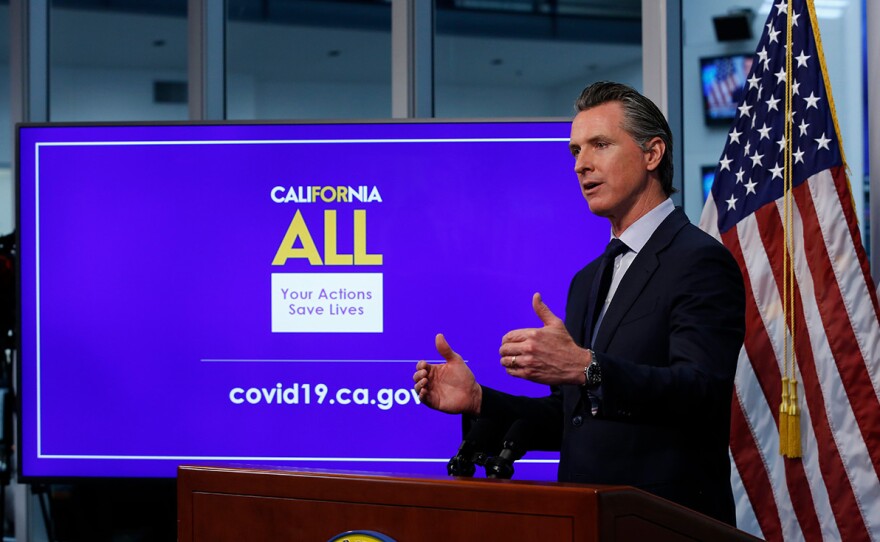California's ambitious plan to double the current number of coronavirus tests is being paired with a massive campaign to track down every person who may become infected by each new person who tests positive for the virus.
Gov. Gavin Newsom said Monday that as part of statewide plans to reopen businesses, California aims to reassign 20,000 public employees as COVID-19 case investigators and contact tracers, a job that requires perseverance, resourcefulness and a bit of sleuthing.
“It’s more complicated than you think," said Dr. George Rutherford, an epidemiologist at the University of California, San Francisco, who helped design a training program for the new workforce. "They have to be fairly creative in finding people. It’s a lot of detective work.”
Newsom had mentioned plans for the program nearly three weeks ago when he discussed creating “an army” of 10,000 workers who would have to track down more than 10 people for each person who tests positive with the virus. At the time, he estimated they would be tracking 2,000 to 3,000 new cases a day if the state hit its goal of testing 60,000 a day.
So far, fewer than 3,000 people are doing the work in about two dozen of the state's 58 counties.
County health departments routinely track down people potentially infected with sexually transmitted diseases or tuberculosis but it's never been done on this scale.
A recent Associated Press review of the U.S. found many states falling short of goals to track cases and scrambling to train enough people for the task, which the federal government also has deemed essential to reopening businesses.
In the early days of the outbreak, counties tried to track down anyone who came into contact with an infected person in hopes of controlling the spread of the fast-moving virus. People suspected of being ill were ordered into quarantine and the people they were in close contact with were told to isolate themselves.
But once the virus spread more widely, that work became difficult to carry out on a large scale. San Francisco Bay Area counties, followed by Newsom, moved to a mitigation strategy still in place that required most people to stay at home and keep a safe distance from others. While some counties are now bucking those orders, others have gone even further in requiring face coverings in public.
In Los Angeles, with more than 10 million people, the county has continued to try to track down those associated with every new case of the virus, Public Health Director Barbara Ferrer said last month. Once the volume of cases took off, it began instructing each infected person to notify their friends, family and co-workers of their status.
“We obviously don’t reach everyone because sometimes we don’t have the right cell numbers or phone numbers and sometimes people don’t wish to talk with us," Ferrer said. “But we reach somewhere between 80 and 90% of people for whom we have a positive lab result.”
The benefit of having most residents at home for nearly seven weeks now is that the number of close contacts is limited to an average of 3.5 people in the Bay Area, accounting mostly for family members or roommates, Rutherford said. But that's bound to rise once people are allowed to leave home more freely.
Even with a small number of contacts, it can be a challenge tracking down acquaintances they may have seen or a neighbor whose full name they don't know.
As an example of how time-consuming the work can be, the University of California, Davis hired four full-time employees last month to trace the contacts of every infected employee at its health system — at a time when it was only finding about one new infection a day among staff, said Dr. David Lubarsky, the chief executive of UC Davis Health.
“Usually these types of things take a longer time than anyone hopes," Lubarsky said. "But, unfortunately, there are a ton of underutilized, unemployed individuals out there who could, no doubt, be convinced to take on a new role during the pandemic.”
Dr. Sonia Angell, the state's health director, said public employees would be reassigned to the work.
A virtual academy will train them to call, text, email or use online chatting tools to notify anyone who has been in close contact with someone infected. They’ll be asked about their symptoms, offered testing, and advised to isolate.
Rutherford said it takes about 20 hours to train someone, though most of that time is spent providing feedback as trainees make contact with those who may have been exposed.
In San Francisco, where the health department went from a staff of 10 to 140 people doing the tracking work by phone, many were librarians whose buildings had closed.
“They got nothing going on," Rutherford said. ”But they’re great. They can speak (different) languages, they’re very skilled. So it works.”







